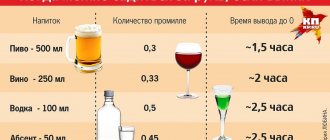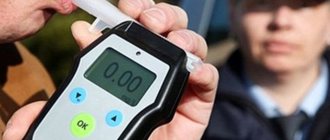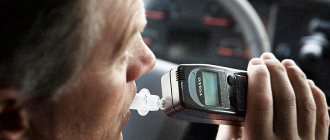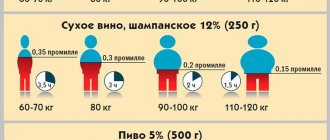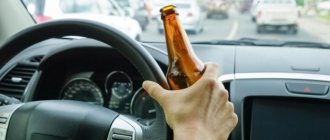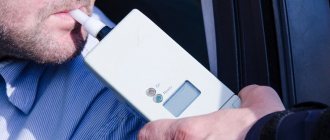What is ppm
This is the name of the indicator; in our case, the degree of alcohol intoxication of a person is established, and it will be calculated based on the amount of alcohol in the blood. If we count purely mathematically, then 1 ppm is equal to 0.45 mg per 1 liter. It is worth considering that alcoholic products remain in the blood for quite a long time, so special devices can accurately determine the presence of alcohol.
Now there are the following ways to determine it:
- the presence of alcohol is determined in the air exhaled by a person;
- The presence of alcohol in the blood is determined by taking a blood test from a vein in medical institutions.
What's happened?
On September 6 last year, a new law was submitted to the State Duma for the first reading, which proposed depriving drivers of their rights with a new method for determining whether a driver is intoxicated. If previously we could be deprived of our rights for containing alcohol vapor in the exhaled air in a concentration of 0.16 mg/liter of air, now we can be punished for containing alcohol in the blood - in the amount of 0.3 grams per liter of blood. But no, of course, no one will take a liter of blood for analysis. A percentage will be calculated.
This is exactly what the new law of 2021 establishes - despite the fact that it was proposed last year, in March 2021 it passed its final reading and was adopted.
Innovations are introduced by the draft Federal Law “On Amendments to Article 12.8 of the Code of Administrative Offenses of the Russian Federation.” View the official text of the bill.
You will also be interested in:
- New fines for abandoning a car in the yard and for washing a car - true or not?
- New law on saliva drug testing in the traffic police in questions and answers
- Is it true or not that the fine for drunk driving will increase in 2021?
Permissible alcohol limit while driving in ppm
Of course, the inspector will not check you for alcohol if there are no certain signs of intoxication and the person is in normal condition. The law requires you to undergo an examination if you have the following symptoms:
- slurred and incoherent speech of the driver;
- unnaturally reddened skin on a person’s face;
- unsteady gait and unnatural posture;
- characteristic smell of alcoholic drinks;
- unstable psychological and emotional state.
All of these symptoms usually appear after drinking alcoholic beverages. If there are characteristic signs, the inspector must draw up an inspection report and send the driver for a medical check.
On-site measurements of ppm are made with a breathalyzer in the exhaled air. Such measurements must take place in the presence of witnesses and the result of the inspection is reflected in the report. In the document, the inspector describes all identified signs of intoxication, information about all persons present during the measurement (full name, address, contact phone number), the amount of intoxication in ppm, as well as the date and time of detection of the violation of the law.
In the event that the driver refuses to undergo the examination or the device shows zero values, he is sent to a medical facility to re-measure the amount of alcohol in the person’s blood, but using a blood test. If you refuse the study, you will definitely be deprived of your right to drive a car for driving while drunk.
In 2021, the permissible standard has not changed compared to last year; it is equal to 0.16 ppm. Therefore, if the device detects a larger number, an administrative violation report will be drawn up against the driver.
It is worth remembering that there are a lot of products, the consumption of which can show a small amount of alcohol on a traffic inspector’s device:
- nonalcoholic beer;
- chocolate candies;
- kefir and other sourdough products;
- kvass;
- sandwich made from black bread and sausage, etc.
Each of these products contains a certain amount of alcohol, which is excreted only after some time. For several years (from 2010 to 2013), this led not only to financial sanctions, but also to the deprivation of the rights of many inexperienced drivers. After many trials, it was decided to abolish the zero ppm and establish a new standard - 0.16 ppm.
In 2021, a certain amendment to the law was adopted; if the driver is unable to exhale into a breathalyzer, for example, in the case of severe intoxication or unconsciousness, then in this case it is possible to take a blood test of the person and determine the degree of his intoxication. If the indicator is higher than 0.35 ppm, then, of course, the offender will not be able to avoid punishment. There is no need to specifically use both methods.
Is this true and is the new law still in effect today?
This is true. Here is the official document card of the 2018 bill on the website of the State Duma of the Russian Federation. Here is the “proof” about the adoption of the law in the third reading. And here is the page of the official website of the State Duma with the law.
As of today, May 25, 2021, the changes have already entered into legal force. The draft new law was adopted in the third and final reading by the State Duma and published on the official government information portal on April 3, 2021 under number 0001201804030052.
Article 2 of the Federal Law states that it comes into force 90 days after the said publication. Consequently, starting from July 3, 2021, the new law is officially in force, and today people have the right to legally deprive people of their rights for alcohol intoxication through a blood test.
Punishment for exceeding the permissible alcohol limit while driving
The law established fairly severe penalties for such violations, because a drunk driver is one of the main causes of car accidents, including deaths. That's why legislators are trying to tighten the penalties for driving while intoxicated.
Let's look at what the offender faces:
- upon initial detection, a fine of 30 thousand rubles may be imposed. and deprivation of the right to drive a car for 1.5-2 years;
- if a citizen repeatedly drives a car while drunk, the amount of the sanction increases to 50 thousand rubles, and the driving license will be taken away for 3 years;
- if a driver who has already been fined and deprived of his license is caught drunk driving a car, then he will be arrested for 10-15 days, these days he will have to sit behind bars;
- if the driver refuses to undergo a medical examination, then the measure will be applied to him, as in the first case.
Note!
If a car owner has transferred control of his vehicle to a person who is intoxicated, he faces liability equal to that if he himself was drunk driving: a 30 thousand fine and deprivation of rights from 1.5 to 2 years. The driver will receive the same punishment.
Many deputies are initiating the imposition of a more severe penalty and demand that administrative liability be replaced with criminal liability. Therefore, you should not break the established rules.
The traffic police offers a 50% discount if the fine is paid on time, but this opportunity does not apply in all cases; this privilege cannot be used if:
- the driver refused to undergo medical examination. examination;
- a person was caught driving a car while intoxicated.
Therefore, in these cases it will not be possible to reduce the fine.
Basic moments
Any type of alcohol includes an alcohol-containing component, since it contains ethyl alcohol or ethanol.
Alcoholic drinks are invariably popular, because after drinking them a person feels a sharp increase in strength, vigor, and improved mood.
But such “stimulants” also have side effects, in particular:
- distraction;
- slower reaction;
- decreased mental abilities;
- impaired coordination of movements;
- decreased visual acuity.
In addition to the physiological effects of alcohol, there are also psychological effects. So a drunk driver can:
- underestimate the difficult road situation;
- be in a false state of excitement or depression;
- find it difficult to make driving calculations.
In addition to all of the above, possible inappropriate behavior is added. This makes it clear why it is prohibited to drink alcohol-containing drinks and foods while driving.
At the same time, a drunk driver is not at all a “deeply drunk” person with completely uncontrollable behavior.
For alcohol to begin its effect, it is enough to drink a little beer or a light alcoholic cocktail.
Many drivers flaunt the fact that to a certain degree of intoxication they can drive a car perfectly. Sometimes you can’t even tell from the driver’s appearance that he is drunk.
But the degree of alcohol tolerance does not change the essence of the matter; it affects any organism. This necessitates the approval of the ppm norm.
But it’s not just alcoholic beverages that pose a danger to drivers. Some seemingly ordinary products contain some amount of ethyl.
Certain medications can also increase your blood alcohol level. Due to this, testing a completely non-drinking person can show the alcohol content in the blood.
Required terms
Permille is a value that determines the degree of intoxication. It is calculated based on blood alcohol content.
A value of 0.1 ppm is equivalent to 0.045 mg of alcohol per liter of blood. Permille is a quantitative indicator.
Measuring the degree of intoxication with its help allows you to accurately determine the presence of ethyl alcohol in the body.
Moreover, this type of measurement can also determine that the driver consumed alcohol-containing products the day before.
Ethyl alcohol takes a long time to disappear from the body. And even when the subject believes that he is completely sober, the test will show the presence of alcohol in the blood.
Photo: period table
This fact should be taken into account when drinking strong drinks before the trip. As an example of calculations, a table of periods of complete elimination of alcohol from the human body.
What products are prohibited?
According to chemical processes, the formation of alcohol occurs from water with the presence of sugar. Due to fermentation, a reaction occurs in which carbohydrates are converted into alcohol.
Many foods are produced using the fermentation process. For example, kefir, kvass, citro. The formation of alcohols in overripe fruits occurs quite quickly.
Some products do not contain alcohol at all at first glance. It is unlikely that the average person would consider the following to contain alcohol:
- chocolate candies;
- nonalcoholic beer;
- warm natural juices;
- oranges;
- overripe bananas;
- yogurt, curdled milk, kefir;
- sandwich made of black bread with sausage.
Imagine the surprise of the driver who ate a piece of rye bread with sausage for breakfast and drank tea with chocolates when, when checked by traffic police inspectors, a certain amount of ppm was detected.
While the zero ppm law was in effect, many drivers were fined and even deprived of their licenses for drinking a glass of kefir or kvass.
This aspect caused a lot of controversy. This was the reason for the amendments to the legislation.
Legal regulation
Changes in legislation are reflected in Article 12.8 and Part 3 of Article 12.7 of the Code of Administrative Offenses of the Russian Federation. How many ppm are allowed now?
Now an unacceptable degree of intoxication is recognized as an amount of ethyl alcohol in a volume that exceeds 0.16 mg per liter of exhaled air.
Before the approval of this amendment, administrative penalties were applied even if 0.01 ppm was detected in the blood. This often led to unreasonable fines and punishments.
As for the liability provided for under these articles, in the event of a primary violation, a fine of thirty thousand rubles is imposed on the driver.
In this case, the driver is deprived of the right to drive a vehicle for a period of one and a half to two years.
In case of a second violation, a fine of fifty thousand rubles is applied and driving of the vehicle is prohibited for a three-year period.
When a fined driver gets behind the wheel while drunk again, he may face administrative arrest lasting from ten to fifteen days.
If a driver refuses a medical examination, he is automatically declared drunk and subject to appropriate punishment.
If a driver hands over control to a person who is intoxicated, he will also be fined thirty thousand rubles and deprived of the right to drive a vehicle for a period of up to two years.
Article 32.7 of the Code of Administrative Offenses also deserves attention. Although the maximum period for which a driver can be deprived of his license is three years, repeated violations are also taken into account.
And the term of imprisonment is added as soon as the previous punishment is completed. All drivers, including those driving a scooter, are subject to liability for drunk driving.
Punishment under the Criminal Code for exceeding the permissible alcohol limit while driving
This violation falls under the category of administrative cases, but in some cases criminal liability arises. Therefore, intoxication will be an aggravating circumstance in the following cases:
- An accident involving victims with serious injuries, when a drunk driver was the culprit of the accident. In this case, the penalty is imprisonment for up to 4 years;
- in case of a fatal accident, a prison sentence of no more than 7 years is imposed;
- if there are 2 deaths, you can end up behind bars for up to 9 years.
Note!
In case of criminal punishment, in addition to imprisonment, a person will be prohibited from driving for 3 years. Drivers often get off with suspended sentences.
Norms are changing
From 2010 to 2013, legislation prohibited any amount of ppm in exhaled air, and this often became the cause of disagreement, since the person did not drink alcoholic beverages, and the breathalyzer showed a positive result. Such situations arose after the driver consumed certain drinks and foods. These include:
| Beverages | Products | Other |
| Kvass | Chocolate candies | Cigarettes |
| Beer with 0% alcohol | Orange | Mouth freshener |
| Kefir | Overripe bananas | Some drugs (Corvalol, Validol, Aflubin, Tinctures and others) |
| Yogurt | Black bread | Amount of endogenous alcohol |
| Warm juice |
The results of the breathalyzer also have an error of ±0.05 ppm, which could also affect the readings of the device.
In this regard, the zero ppm law was repealed on July 23, 2013.
Recommendations for drivers to avoid losing their driver's license
If you drank alcohol and for some reason had to get behind the wheel, but you don’t want trouble on the road, then you should follow the rules as much as possible:
- the best option is not to drive, but if there is no other choice, then it will be better if as much time as possible passes between drinking alcohol and driving;
- do not take medications, especially those containing ethyl alcohol;
- do not consume kvass and fermented milk products, as they can increase the amount of alcohol in the blood;
- the use of chewing gum may be regarded by the inspector as an attempt to hide traces of alcohol;
- Do not enter into conflict with the inspector under any circumstances, this will only aggravate the situation.
0.3 grams in the blood - how much is it in ppm?
Despite the fact that on many resources you will find information about the ratio of these types of quantities, they cannot be converted and compared.
The fact is that ppm is essentially a percentage (tenths), that is, the ratio of two numbers. But it is wrong to compare 2 numbers if they both measure completely different quantities: one is grams (mass), the other is volume (liter). Thus, 0.3 grams of alcohol in the blood is not ppm and does not count. That is, it is a mistake to believe that the new law has returned the good old ppm for determining alcohol intoxication. Not at all, a somewhat new technique for identifying drunk drivers is being introduced.
Will they be deprived of their rights if only one indicator is above the norm?
Yes. To have a violation falling under Part 1 of Article 12.8 of the Code of Administrative Offenses, only one of the specified standards must be exceeded, and not both. This is clearly indicated by the conjunction “or”. That is, if at least one of the indicators is higher than the norm: 0.16 mg of alcohol per liter of exhalation or 0.3 grams of alcohol per liter of blood, then your rights will be deprived.
We bring to your attention an alcohol calculator, where you can calculate how long after you can drive after a certain amount of drink.
Summary
The driver will not be able to deceive the modern devices of traffic police inspectors. Therefore, you should not exhale a little or, conversely, inhale air; in any case, the breathalyzer gives true readings. If a deviation from acceptable indicators is detected, a protocol on an administrative offense will be drawn up against a citizen.
Not only traffic safety on the road, but also human lives depend on the condition of the driver behind the wheel. Therefore, the best option, if you have drunk alcohol, is to ask a sober person to take you home or use public transport so as not to endanger yourself and others.
ATTENTION!
Due to recent changes in legislation, the information in this article may be out of date!
Our lawyer will advise you free of charge - write in the form below.
Where is alcohol more likely to show: air or blood?
However, you can roughly calculate how much it is - 0.3 grams (300 milligrams) per liter of blood. When compared to exhaled air, the permissible dose of alcohol in the blood is quite a bit higher than in the air. 0.16 mg/liter of air is approximately 0.32-0.33 g/liter of blood. That is, in theory, the new law establishes less stringent restrictions and, it would seem, in the case of residual alcohol (when you drank yesterday, and they “blow you through” today) it would be better to donate blood.
But no. The fact is that alcohol comes out of exhalation (from the lungs, to be more precise) much faster than from the blood. So, if you, for example, drank 2 bottles of beer, then after a few hours the concentration of alcohol vapor in the exhaled air may be less than 0.16 mg per liter. But alcohol stays in the blood longer - about 2-3 days (but it can be less or more - this greatly depends on the characteristics of a particular person’s body). And with large volumes of consumption, the device will show values of 0.3 grams per liter of blood for much longer.
Oh yes, about the device...
What foods and medications can show blood alcohol levels?
After consuming some harmless drinks and foods, the traffic police inspector’s device can detect alcohol in the driver’s blood. Dangerous products that motorists should avoid consuming:
- kvass (0.4–0.6 ‰);
- kumiss (0.3 ‰);
- non-alcoholic beer (0.2 ‰);
- rye bread with sausage (0.2 ‰).
Canned juices are also dangerous for drivers. In the manufacture of these products, alcohol concentrates are used. If the package has been open for some time, fermentation processes begin in it. After drinking a drink, a small dose of alcohol will definitely be present in a person’s blood.
Kefir is completely safe for drivers who often spend time behind the wheel. For a breathalyzer to detect alcohol, you need to drink 10 liters of this fermented milk product.
Contains alcohol:
- some candy;
- rum buns;
- overripe fruits (bananas, oranges, tangerines);
- refreshing mouth spray.
After consuming dangerous foods, the breathalyzer shows alcohol (ppm) in the blood for 20–30 minutes.
Any medicinal tinctures with alcohol, taken in quantities of 40 drops or more, show 0.1 ppm.
Let's look at foods that are not recommended to be consumed immediately before a trip. They cause fermentation and release of some alcohol.
These include:
- juices;
- fermented milk products;
- overripe bananas;
- kvass.
This also includes oranges and beer with zero alcohol content. It is also not advisable to use mouth fresheners, since they contain ethanol.
As for drugs, their list is quite large, since medical alcohol is a mandatory component of many of them.
We list the most popular medications:
- Rhinital (ethanol-containing homeopathic medicine).
- Canephron N.
- Biovital (hawthorn extract containing alcohol).
- Bittner (alcohol content reaches 40%).
- Licorice root (syrup).
- Levovinisol.
Among drugs with a high content of ethyl alcohol (43%) the following should be highlighted:
- Asinis in drops.
- Aflubin.
- Vokara and Gentos.
These medications include:
- Valocordin.
- Barboval.
- Valoserdin.
These drugs are based on ethyl alcohol and phenobarbetal. We also note the well-known Corvalol, which in addition to alcohol contains barbiturates.
You should not purchase drugs that are actively advertised in the media, removing all signs of alcohol intoxication and the characteristic odor. Such drugs simply do not exist in nature. They may block the characteristic odor, but they have no effect on the breathalyzer readings.
Let us note that knowledge of the established standards for the content of ethanol in the blood and their strict implementation will save drivers from the serious consequences of an accident, as well as paying significant amounts of fines due to their own carelessness.
Determination of blood alcohol content
Until recently, there was only one way to give an objective assessment of a person’s condition, as well as the presence of ethyl alcohol in his body, through an analysis of its content in the blood. But in some cases, for example, on highways and highways, it is almost impossible to determine in this way whether a drunk person is driving a car or not.
In this regard, mobile devices have been developed to detect the presence of alcohol - portable detectors. Their job is to detect alcohol based on an analysis of the volume of air exhaled from the lungs. When calculating the volume of alcohol in the human body, a number of parameters are taken into account.
These include:
- percentage ratio of alcoholic beverage content to the total weight of the person being examined;
- weight indicators;
- gender of the person being examined;
- total amount of fluid (in the body of the person being examined);
- the amount of ethanol contained (in the volume drunk).
The stage of intoxication of a citizen can be determined independently. For example, let’s take the following parameters: a person’s weight is 80 kg, the volume of vodka drunk with 40% alcohol content is 250 mg, the volume of fluid in the body of an adult is 70%.
Thus, the volume of liquid will be 80(kg) x 70(%)=56 kg. The amount of pure ethanol in the body will be equal to 250 (mg) x 40 (%) = 100 mg. Taking into account the density of ethyl alcohol, we obtain the volume of pure ethanol: 0.79 g/mol * 100 mg = 79 g.
When calculating, an error is taken into account, which does not exceed 10%, so the exact amount of pure ethanol is 71.1 g. Taking into account the above data, it is easy to calculate the number of ppm. It will be 71.1/56=1.27.
How many ppm is acceptable in other countries?
The legislation of different states differs depending on the legislator and the legal system. If you understand the requirements of foreign laws, you will be able to avoid getting into an unpleasant situation when traveling by car, or simply develop your horizons. Please note that in most countries, blowing through a straw is not used; a blood test is taken and the alcohol concentration is determined.
In Spain
0.3 ppm is allowed, because any device can give errors and show a small alcohol level. At 0.5, a mild degree of intoxication begins, which means corresponding responsibility begins. It is noteworthy that for those who do not have much driving experience, the standard is set to 0, that is, the slightest fraction of ppm can lead to a fine or other punishment. By the way, a similar situation is observed in Portugal, Croatia and many European countries.
In Belarus
For citizens of the Republic it is allowed to use:
- For men weighing up to 80 kg, 0.5 liters of beer, the strength of which does not exceed 6 degrees. For representatives of the fairer sex, whose weight does not exceed 65 kg - 0.33 liters.
- Men are allowed to drink 50 g of cognac, women 30 g.
- Regarding wine, men have the right to afford 125 g of drink, women 75.
It is important to remember the anatomical features, weight and height, and fullness of the citizen’s stomach. All this affects the final result. According to the law of Belarus, no more than 0.3 ppm of alcohol is allowed.
In Ukraine
The Ministry of Internal Affairs of Ukraine issued Order No. 400, which sets the permissible level of alcohol in the human body at the federal level. It is 0.2 ppm. This is the lightest and lowest degree of intoxication, it is called preclinical, that is, it has no accompanying symptoms. Alcohol in such content does not affect human behavior, coordination, attentiveness, and there are no manifestations in external properties. A person is completely adequate and understands the essence of his actions and can control the situation.
In the DPR
Officially, the traffic police of the Ministry of Internal Affairs of the DPR established several degrees of intoxication:
- The lightest is from 0.5 to 1.5 ppm.
- Average – from 1.5 to 2.5.
- Increased – from 2.5 to 3.
- Severe, poisoning with products containing alcohol - from 3 to 5 ppm.
When checking a driver, no more than 0.3 ppm is allowed on a breathalyzer. Increased indicators are grounds for detaining a person and imposing punishment on him.
In Germany
The German legislative system is not simple, so alcohol also has its own peculiarities. For example, a driver who is caught under the influence of alcohol will have to pay a fine of 500 euros, the next time the fine increases to 1000 euros, and for the third offense 3000 euros.
The maximum permissible value is 0.5 ppm. If the driving experience is less than 2 years, or if the driver has not reached 21 years of age, not the slightest indicator is allowed, that is, the device must indicate 0. The same rule applies to taxi drivers. If the offender is caught for the third time or the first time, but the dose is 1.6 ppm or more, the police officer will refer the person for testing. It costs 500 euros, and based on the results, the person is either sent to re-enroll in school or loses his or her rights.
In Finland
State legislation allows alcohol concentrations of no more than 0.5 ppm. Otherwise, the driver faces arrest, imprisonment or more severe punishment. The authorities categorically prohibit novice and inexperienced drivers from being in a state of any kind of intoxication. The principles of liability are identical to those laid down in Germany.
In Italy
Italy is a typical European country, which is characterized by strict sanctions and established standards of intoxication. The allowed blood alcohol content is no more than 0.5 ppm. For an indicator above 0.5 but less than 0.8, the driver will have to pay a fine of 160 euros. For an increased concentration of alcohol you may be subject to deprivation of rights for up to 8 months and a fine of 700 euros.
How to check your alcohol level
Alcohol testing is not a rare procedure, as many people might think. Drivers are not the only group of residents with the need to monitor and control the amount of alcohol in their blood. Drivers are subject to alcohol testing in 2 situations:
- When a vehicle becomes involved in a traffic accident, testing the body for alcohol content is considered an integral part during the investigation and investigation of the circumstances of the accident.
- When, during a scheduled check or operation of a sober driver, a traffic police officer suspects that the driver of the car is intoxicated.
The traffic police officer sends the driver for a medical examination if he has reason to believe that the driver is drunk. This may be affected by the presence of the following symptoms:
- aroma of alcohol on breath;
- instability and delayed reaction;
- speech problems;
- red or pale face;
- inappropriate behavior, waving arms, screaming, suffering reaction to the situation.
In blood
A blood alcohol test is a laboratory test that proves the presence of ethyl alcohol in the body and also establishes the level of intoxication. This is considered a significant condition during the trial. To determine the amount of alcohol in the blood, the unit of measurement used is ppm. 1 ppm - 0.1%.
Measurement
The amount of ppm is measured by “blowing” into a breathalyzer, or by taking blood - a medical examination.
When testing for alcohol intoxication by determining the amount of ppm in the exhaled air, you should adhere to the following recommendations:
- the breathalyzer must be turned off, and the mouthpiece must be in individual packaging, which is unpacked in front of the driver;
- the car enthusiast tightly wraps his lips around the mouthpiece and exhales air into it until a signal appears;
- the result that appears on the screen must be shown to the driver and recorded in the report.
Medical examination for alcohol intoxication is carried out only in specialized institutions licensed for this type of work. In the hospital, a second “purging” is carried out and blood is taken for a chemical and toxicological study for determination. The analysis is taken from a vein in a volume of 15 ml. The puncture site is treated with a disinfectant solution that does not contain alcohol to avoid incorrect tests. The results will be ready in 13 days. A urine test is not taken to determine alcohol intoxication, since traces of alcohol can be detected in it even with zero readings in the blood.
Concentration (in ppm) of alcohol in the blood of women
When determining the volume of alcohol in the blood of males, which does not exceed 0.3 ppm, it is considered that the person is absolutely sober and can drive a vehicle. If these data fluctuate between 0.3-0.5, it means that the effect of ethanol on consciousness is insignificant.
If the level of ethanol fluctuates within one and a half ppm, this indicates a mild stage of intoxication. It is strictly prohibited to drive a car in this condition. If the concentration of alcohol in the blood exceeds 1.5, but not more than 2.5 ppm, the degree of alcohol poisoning is considered to be moderate.
An ethanol concentration of 3 ppm indicates severe intoxication of the person being examined. The presence of ethyl alcohol in a volume of up to 5 indicates a severe degree of poisoning. Above these indicators, as a rule, the diagnosis indicates a fatal outcome.
As we have already said, the proportion of water in the male body is about 70%. This means that ethyl alcohol disappears much faster when compared with similar indicators for a woman. Thus, a man’s body is capable of processing about 0.15-0.17% of the total volume of alcohol consumed in 60 minutes.
It is known that the absorption of alcohol in women occurs faster, and it takes much longer to eliminate it, compared to men.
This is due to the fact that the fluid content in the female body is only 60%. Therefore, the rate of ethanol elimination in 60 minutes is 0.1% of the volume of drinks consumed.
